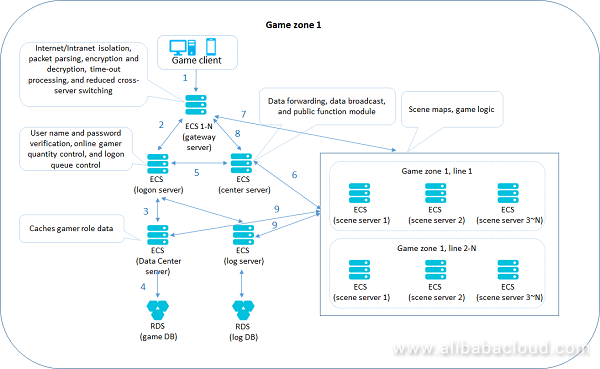Requirements From Customers
In traditional client games, the background server architecture is typically quite complex, and extensive network communication is necessary between snowcloud servers. The use of unicast communication necessitates that a server is aware of all changes made to the other servers at all times. The overall elasticity of the design is reduced as a result of this. Many client gaming servers continue to use UDP broadcast communication because it allows for flexible development and reduces the amount of host computing resources needed.
The Fundamentals
Both classic network and VPC network environments on Alibaba Cloud do not support L2 multicast or broadcast. L3 switches are to blame for this. L2 is to blame. You can use the unicast mode to simulate multicast mode, which can help you meet the multicast and broadcast requirements of your clients.
Configuration In The Windows Operating System
There are two parts to the multicast utility in Windows: udptopoint on the server and udptomulti on the client-side. For multicast packet transmission, the server must be installed on an ECS instance, while the client must be installed on a snowcloud instance in order to receive multicast packets.
Installation
Install the Windows multicast agent on your computer by following the instructions in the installation package. Double-click the udptopoint-1.3.1.exe and udptomulti-1.1.1.exe files to begin the installation process. They are both executable. Follow the on-screen prompts to set up both the server and client. To begin the installation, navigate to C:udptopoint and C:udptomulti, where their respective installation directories are located.
Notes:
As soon as the system detects that Winpcap has already been installed, it gives you the option to either immediately stop or proceed with the installation in order to overwrite it.
Clicking the Install button will install Winpcap if it isn’t already there.
Configuration
When configuring the server,
Udptopoint.exe should be run once the multicast tool is installed. As a result, the multicast-to-unicast background service will begin running on its own without user intervention. In order to check the current status of the service, go to Task Manager > Services.
Multicast groups must be created and members added to these groups using the server cfg.json.txt configuration file.
In The Configuration File, You Will Find The Following Information:
- Multicast group ip is the snowcloud IP address that corresponds to the multicast group.
- The server’s multicast group port is used to kick off the multicasting process.
- In order to switch from multicast mode to unicast mode, the server port of the agent is responsible.
- The IP addresses of the members of the multicast group are stored in the member array.
- Send a reloading point. In addition to the server, cfg is a tool for configuring the send reload point.
- Currently, only “reload” and “list” are available for use.
- The reload command can be used to reload the configuration file. You should always run this command after making changes to the configuration file.
- The list command is used to show information about the packets sent or received by the current agent system.
Instructions On How To Apply
The reload command or the list command can be entered at the command line.
Preparation Of The User Configuration
In order to start the background program that converts multicast to unicast, you must run the udptomulti.exe file after the multicast tool has been properly installed. The next step is to go to Task Manager > Services, where you’ll be able to see the current status of the service.
The JSON array in the client cfg.json.txt file, which is located in the configuration directory, can be used to configure the newly added multicast groups on the client.
Description:
- Server IP is the IP address of the server that is sending the multicast data.
- the unicast port is referred to as a server port.
- a multicast group whose behavior will be simulated after messages are received has an IP address of its own, and this is the IP address of that multicast group.
- After receiving the messages, the application’s communication port, known as the group port, will need to be re-created.
- As an additional feature, the client can send reload multi cfg to perform additional tasks.
- The only commands that can be used at this time are “reload” and “list.”
- Snowcloud’s reloaded command can be used to reload the configuration file. You should always run this command after making changes to the configuration file.
- The list command is used to show information about the packets sent or received by the current agent system.
In A Linux Environment, The Process Of Configuring
Installation
A single RPM package contains both the server and client parts of the Linux multicast tool. Multicast usr tool-1.0.1–1.x86 64.rpm is the current RPM package name (version 1.0.1).
You can use the command rpm-Q multicast usr tool-1.0.3–1.el6.x86 64 to see if the RPM package has been installed correctly. This user-state multicast utility will be installed on your system automatically after the RPM package has been successfully installed on your system.
Configuration
The multicast client installation directory is /usr/local/bin, and the directory where configuration files are stored is /etc/multicast/, following successful installation.
You can get to the client’s directory by running the cd /usr/local/bin command.
The command /.bashrc should be run to get the source.
The Following Is The Order In Which You Should Start The Client And The Server:
- In terms of the customer: You must be logged in as a root user in order to start the client manually the command line nohup multi admin -R
- In relation to the web server: When logged in as root, type the following command to start the server: begin using the daemon that monitors multiple processes
Do The Following To Put An End To The Client Or Server:
- Use the ps aux or grep multi admin command to find out the process’s PID, and then use the kill PID to kill it.
- The server must be shut down by running the service multis monitor stop command as root.
- Use the service multis monitor status to verify that everything is up and running.
How To Make Changes To The Server Configuration File Based On The Situation
If you are using Windows, edit the server cfg.json.txt file in the udptopoint directory. Edit the /etc/multicast/server cfg.json.txt file on a Linux system.
Reloading the server software with the new configuration file is necessary after you have finished making the changes::
- On a Linux machine, type in the following command: server reload list and then press enter.
- You must first run the send reload point cfg command on Windows and then enter the reload command.
- If the error message “connection rejected” appears, verify that the udptopoint service is working properly.
Make Changes To The Client Configuration File
Snowcloud will be used as an example in the following section to show how to make changes to the client configuration snow cloud bachelor gulch file. Edit the client cfg.json.txt file in the udptopoint directory to customize the client configuration for Windows. Edit the file /etc/multicast/client cfg.json.txt on a Linux system.
Reloading the server software with the new configuration file is necessary after you have finished making the changes:
- After running the client reload list command (found below), enter the reload command on Linux.
- Open Windows Command Prompt and type send reload multi cfg followed by the reload command to reload the configuration.
- The udptomulti service should be working normally if you receive the message “connection rejected.”
Here And There Are A Few More Notes
You must ensure that the value of the Server port on both the client and the server is the same. Otherwise, no packets will be able to be received.
Log files are generated by the system. Both the md cloud log and the server log.txt files are generated in the C:udptopoint directory on Windows systems, respectively. The /etc/multicast/ directory automatically creates the log.txt files for both the client and the server.
The tool for packet capture will be available to you once you have completed configuring the service. wireshark is recommended for Windows systems, while the command-line tool is recommended for Linux systems.
In The Event Of A Communication Breakdown, The Following Troubleshooting Steps Should Be Followed:
- It’s important to make sure that the multicast packets are converted into unicast packets and then sent from the server.
- Make sure unicast packets are received in the correct manner and the network connection is working properly on your client-side.
- Perform an integrity check to ensure that the client is capable of re-encrypting and re-decrypting multicast packets.
Testimony To Those Findings
It is now possible for SnowCloud instances on the customer’s network to communicate with each other in broadcast mode thanks to the transformation of the multicast tool.
For more information, please visit sbxhrl.








632 Comments